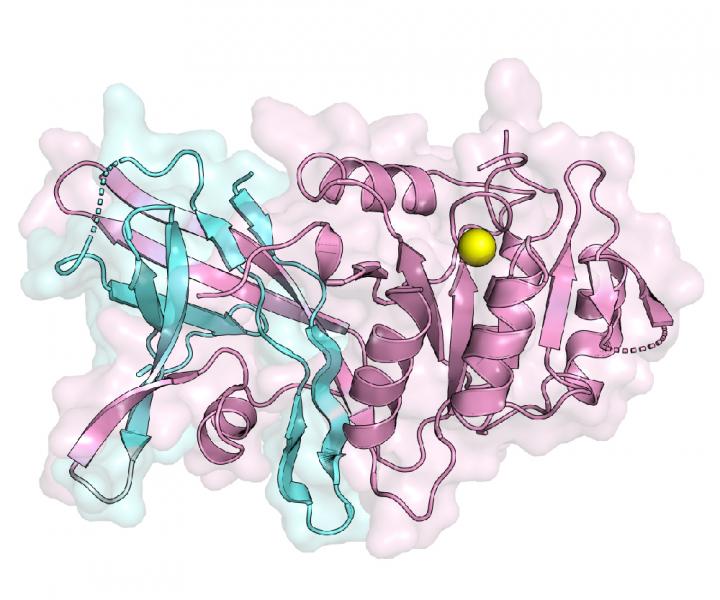The finding may help to better understand heart disease, obesity and diabetes

Credit: Stony Brook University
The News in Brief:
- Researchers visualized the first structure of a lipin enzyme – which helps make triglycerides – a first after 20 years of research.
- Creating the structure enabled researchers to see how two regions (N-lip and C-lip) come together to form a functional enzyme and better understand how lipins regulate triglyceride production.
- The structure is helping the team to understand how mutations in lipins lead to abnormal production of triglycerides central to diseases such as heart disease, obesity and diabetes.
STONY BROOK, NY, March 10, 2020 – The first structure of a lipin enzyme, which carries out an important step in the production of triglycerides, the main reservoir for long-term energy storage, will help scientists to better understand how lipins regulate the production of triglycerides. Led by Mike Airola, PhD, of the Department of Biochemistry and Cell Biology in the College of Arts and Sciences and Renaissance School of Medicine at Stony Brook University, the structure also provides scientists with insights as to why mutations in the enzyme cause a loss of activity that leads to abnormal production of triglycerides implicated in heart disease, obesity and diabetes. The study will published in Nature Communications.
Lipins complete the second to last step of triglyceride production. But when mutations interrupt lipin functions, the body loses its ability to store fat properly, thus potentially triggering a wide variety of metabolic-related conditions. Scientists have unsuccessfully tried to create the first visual structure a lipin enzyme since these enzymes were identified in 2001. Now Airola and colleagues successfully explain in the paper their first crystal structure of a specific enzyme called lipin PAP.
“This structure answers a long-standing question for how two essential regions, N-lip and C-lip, which are located on opposite ends of this protein in humans, come together to form a function enzyme to help make triglycerides,” explains Airola, Assistant Professor in the Department of Biochemistry & Cell Biology and director of the Airola Lab. “Using this structure also helps us understand how the protein interacts with membranes, which is key to regulating its activity and the production of triglycerides.”
The team used X-ray crystallography, mass spectrometry and biochemistry to visualize the structure, which represents the active state of a lipin enzyme during the production of triglycerides, as well as its other functions namely lipoprotein assembly and cellular signaling.
Valerie Khayyo, a Stony Brook graduate student in the Biochemistry & Structural Biology Program and first author of the study, added that the structure enables researchers to understand and see specific mutational changes in the amino acid building blocks of lipins that result in disease.
Khayyo noted that mutations in lipins are increasingly being identified in patients with muscle disorders as well, such as statin-induced myopathy and extreme cases in childhood rhabdomyolysis.
Overall, Airola says that the structure and study consolidates many previous observations into a unifying framework and sets the stage for scientists to resolve several remaining important questions concerning how lipins are regulated.
###
Collaborators include Karen Reue at UCLA who first identified lipins as proteins involved in triglyceride metabolism, and John Burke at the University of Victoria, Canada.
The research is supported by grants from the National Institutes of Health (R35GM12866), the American Heart Association, and the Canadian Institutes of Health.
About Stony Brook University
Stony Brook University, widely regarded as a SUNY flagship, is going far beyond the expectations of today’s public universities. With more than 26,000 students, 2,700 faculty members, nearly 200,000 alumni, an academic medical center and 18 NCAA Division I athletic programs, it is one of only four University Center campuses in the State University of New York (SUNY) system. The University embraces its mission to provide comprehensive undergraduate, graduate, and professional education of the highest quality, and has been ranked among the top 35 public universities in the nation by U.S. News & World Report. Fostering a commitment to academic research and intellectual endeavors, Stony Brook’s membership in the Association of American Universities (AAU) places it among the top 65 research institutions in North America. The University’s distinguished faculty have earned esteemed awards such as the Nobel Prize, Pulitzer Prize, Indianapolis Prize for animal conservation, Abel Prize and the inaugural Breakthrough Prize in Mathematics. Part of the management team of Brookhaven National Laboratory of the U.S. Department of Energy, Stony Brook is one of only eight universities that has a role in running a national laboratory. Providing economic growth for neighboring communities and the wider geographic region, the University totals an impressive $7.23 billion in increased economic output on Long Island. Follow us on Facebook (https:/
Media Contact
Greg Filiano
[email protected]
631-444-9343




